Like the irresistible pull of a black hole, mobile devices are consuming more and more of our time.
Between infinite-scrolling social media apps, responsive mobile websites with sharply designed visual content and web conferencing platforms that can engage participants for hours on end, it’s no wonder that time spent on smartphones and tablets has kept rising, seemingly unstoppably. Per eMarketer, mobile users spent over three hours per day on their phones in 2020 — up 28% just since 2018 — and could add another eleven minutes to their total by 2022.
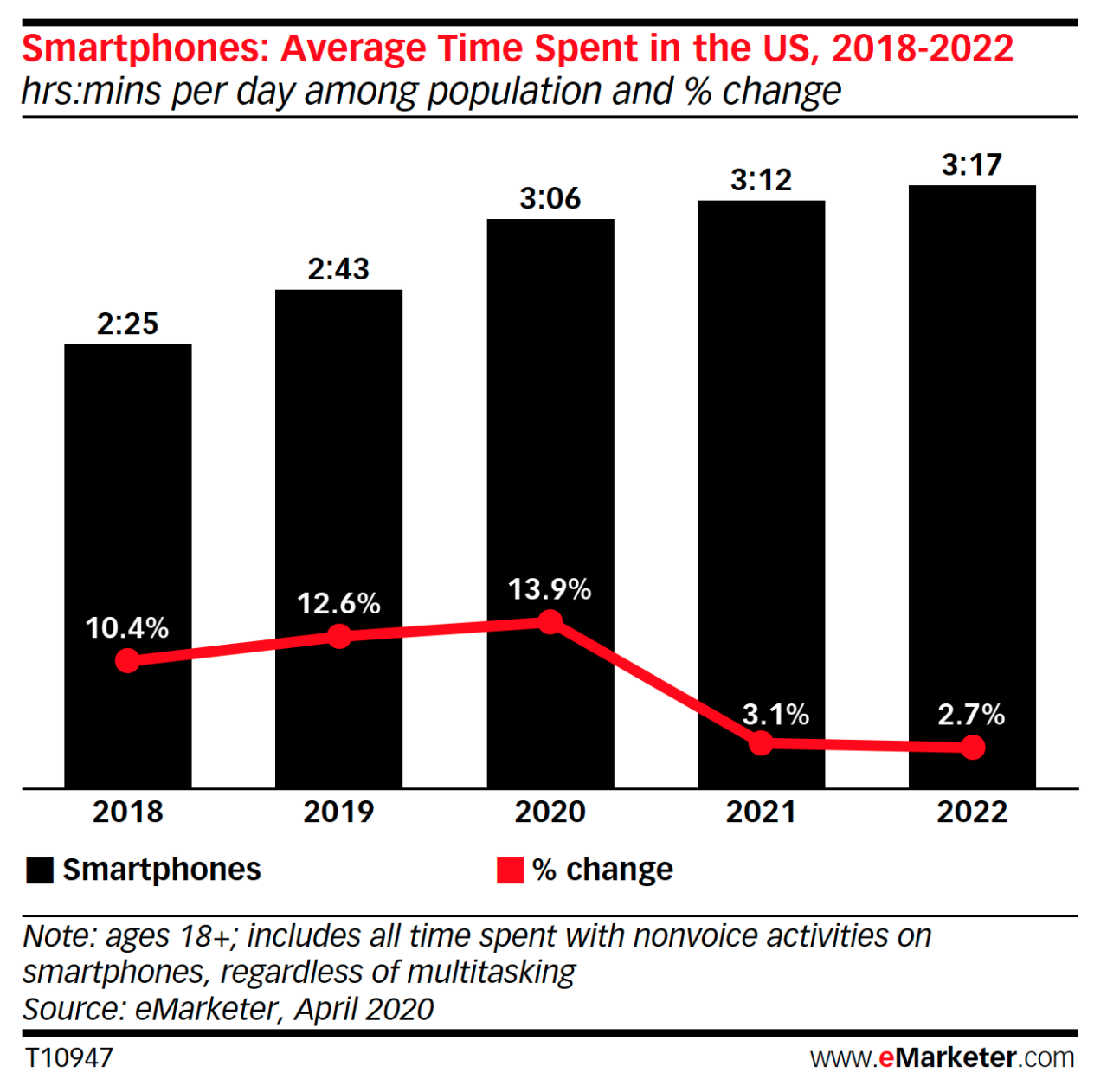
With smartphone users now generating a majority of all internet traffic, content marketing should first and foremost be mobile content marketing, since that’s where the target audience increasingly is. If mobile devices and apps are indeed similar to a black hole for our attention spans, then mobile marketing strategies are sort of like wormholes — transporting us, as mobile users, to new destinations, but in this case with much better targeting and a smoother overall journey.
What is mobile content marketing?
Mobile content marketing is a multichannel marketing strategy whose conceptual, technical, visual, textual and campaign-related components are all optimized to engage mobile users. It’s important because, for a majority of internet users, mobile devices are the main portals through which they now look for answers to questions, read articles, view social media and watch videos.
Because Google switched to a mobile-first index of pages in 2019, a mobile content marketing strategy can essentially be your default content marketing strategy. Plus the same tools you might already be using for creating content and performing SEO on desktop — such as Adobe Creative Cloud, WordPress, Google Search Console, SEMrush, etc. — can be used in a mobile content strategy, too.
The mobile content that such a marketing strategy produces (like articles, white papers and infographics) can ultimately be shared across company-owned channels like an official blog or app, on social media platforms, via email, as gated assets and/or through native and other forms of mobile advertising. Overall, mobile content marketing is a holistic approach to mobile marketing, with a focus on:
Length, style and formatting of written and visual content
Because mobile users are likely to be on the go and also distracted by app notifications multitasking, mobile content must be succinct and every custom mobile app development service must follow this. Short paragraphs, casual voice, subheads and integrated visuals all help keep them consistently engaged. For visual assets, cohesive and eye-catching design is similarly important for reaching the target audience.
Website and app design
To ensure this content displays properly on mobile devices, marketers often rely on responsive web design, or RWD. This approach to website building makes a page render differently in response to each device’s screen or window size to achieve the best possible experience when reading and viewing, plus maximum SEO benefits. Mobile apps may also be used for streamlined content distribution.
Supporting imagery, video and audio
Embedded videos, custom illustrations, CTA buttons, charts and other graphics don’t just look great within mobile content marketing — they also boost brand recognition and stick with mobile users for longer than written content does. Audio is also important to mobile content marketing, e.g. for voiceovers and podcasts.
Mobile SEO
A mobile content marketing strategy needs mobile SEO to boost content discoverability in SERP pages for targeted keywords. Mobile SEO involves much more than proper keyword selection. Going back to our second point, a mobile-optimized website is also critical to mobile SEO, as is loading speed, removal of interstitial pages and inclusion of all content from the desktop version.
Taking a step back, mobile content marketing is a subset of mobile marketing, which includes other types of marketing that leverage SMS, iMessage, in-app ads, banners and QR codes. Compared to these types of mobile marketing, content marketing is more focused on written and visual content as well as mobile search, and less on overt advertising, although as mentioned earlier, ads still play a part in many mobile content marketing strategies.
This page from Sprout Social shows what effective mobile content marketing can look like:
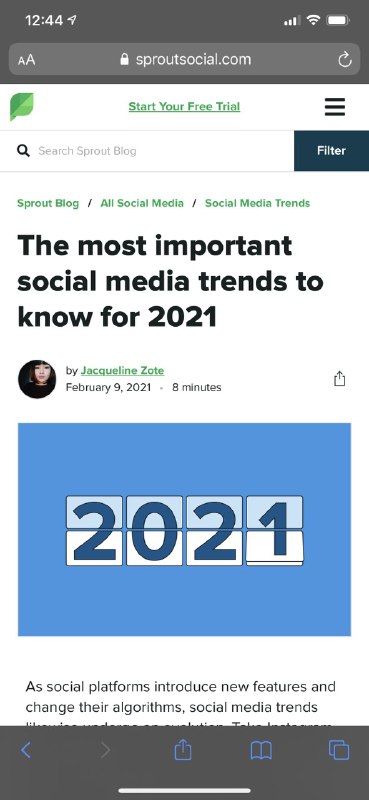
Note the clear, bolded headline, the immediate use of graphic illustration and the ability to see just a little bit of text that continues off the page, all of which helps engage mobile users. The page elements like the compact “accordion” menu and the large search bar also indicate a mobile-friendly responsive design.
Further down, short paragraphs, an embedded video and another subhead break up the blocks of text for a reading experience that’s easy to follow even on the go:
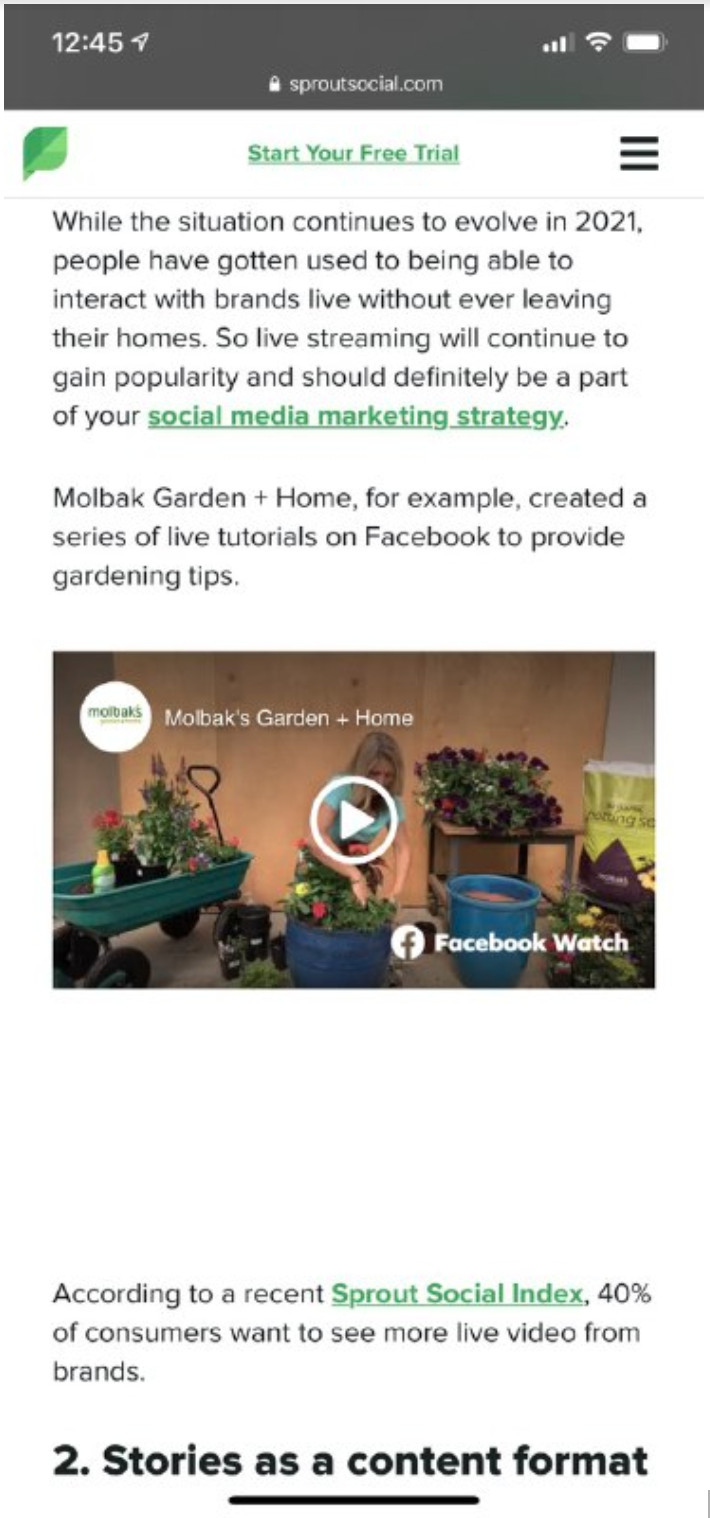
Who is mobile content marketing for?
Both B2B and B2C marketers rely on mobile content marketing, albeit in slightly different forms.
B2B
Mobile content strategy is integral to B2B marketing. In fact, it’s more popular than any other type of marketing, including digital ads and email marketing:

Another way to look at mobile content marketing in a B2B context is as a form of presales: It’s a way to identify, nurture and qualify leads within the relatively long B2B sales cycle. For instance, B2B marketers may design a mobile content strategy around blog posts offering an in-depth look at how a specific product works, using examples, and pair it with a social media campaign. Google Workspace, an enterprise collaboration platform, benefits from such a mobile content marketing strategy across the official Google blog and Twitter:
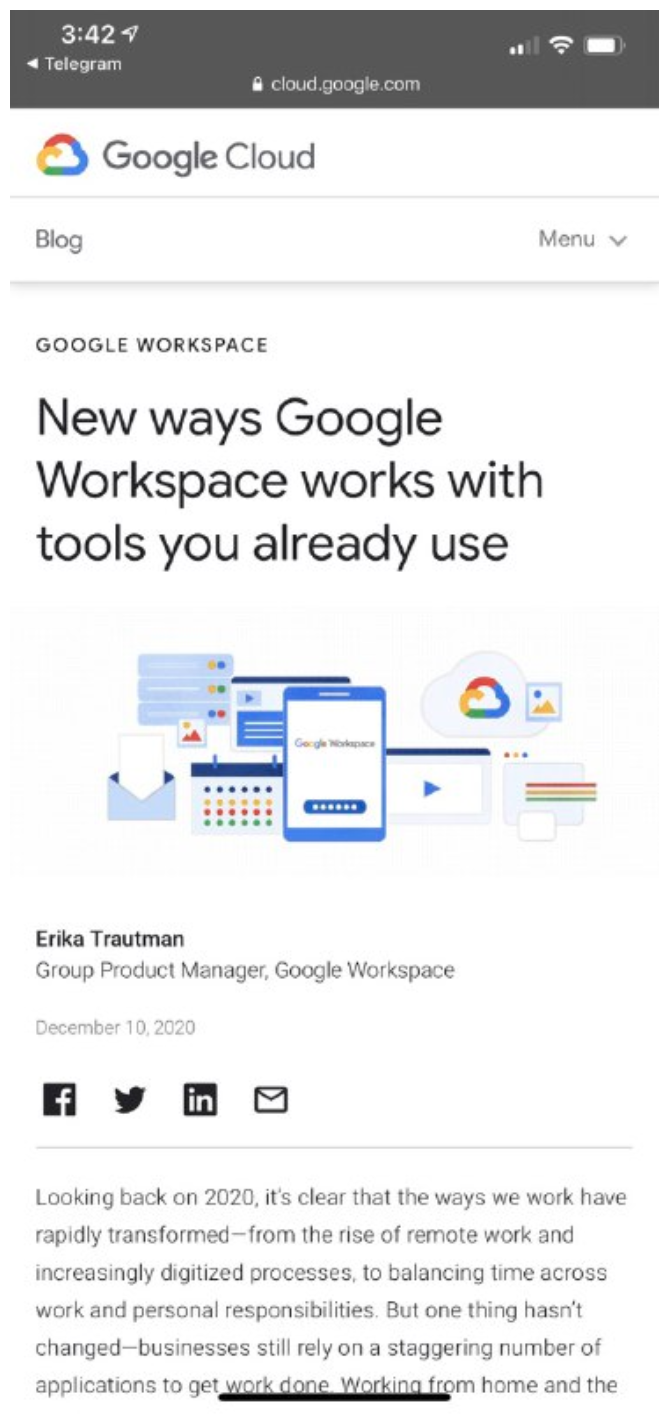
The blog post features engaging visual content right at the start, similar to the Sprout Social example, and lives on a responsive page with prominent social media sharing links.
Meanwhile, the product’s official Twitter account uses the same framing of the blog post by emphasizing how it works with apps that the target audience likely already uses, like Gmail. Not only does it include a link back to the post, but it also features an embedded video with a quick overview of common actions.
Work with tools you’re already familiar with and save time with helpful intelligence, faster workflows, and increased collaboration in #GoogleWorkspace. Learn more → https://t.co/Nc895R5JRV pic.twitter.com/Fr9zB6QZKI
— Google Workspace (@GoogleWorkspace) December 10, 2020
B2C
B2C marketers generally have less time to make an impression on mobile users, due to shorter sales cycles and more competition. Accordingly, their mobile marketing strategies tend to be more emotional and attention-grabbing.
This email from Nespresso shows how powerful words like “bold” and “intense” can be combined with a colorful image and the classic “while supplies last” nudge into an effective mobile content strategy, one that renders nicely on a mobile device screen (the entire image and text through “spice’ is visible in the Gmail app on an iPhone 12).

Compared to B2B content marketing, B2C marketing on mobile is less about slowly nurturing and qualifying leads, and more about quickly responding to the wants, needs and emotions of the target audience. Visual content and gripping, emotional text like in the above are especially important, whether marketing via email, an app or a blog article.
What are the benefits of mobile marketing?
The purpose of mobile marketing is to connect with and engage a target audience (mostly smartphone users in this context) and make them likelier to convert. Done right, its benefits include:
- Higher engagement of customers early on in the buyer’s journey, as exemplified by the fact that over 60% of B2B buyers have cited podcasts as an important content type.
- Superior brand awareness that helps target audiences understand what a brand stands for, through tightly aligned content that embodies core brand values.
- Visibility through mobile SEO and social media presence, both of which can lead to increased conversions.
A proper mobile content marketing strategy can be particularly beneficial in reaching relatively young target audiences, who are disproportionately likely to be smartphone users, as a HubSpot study revealed:
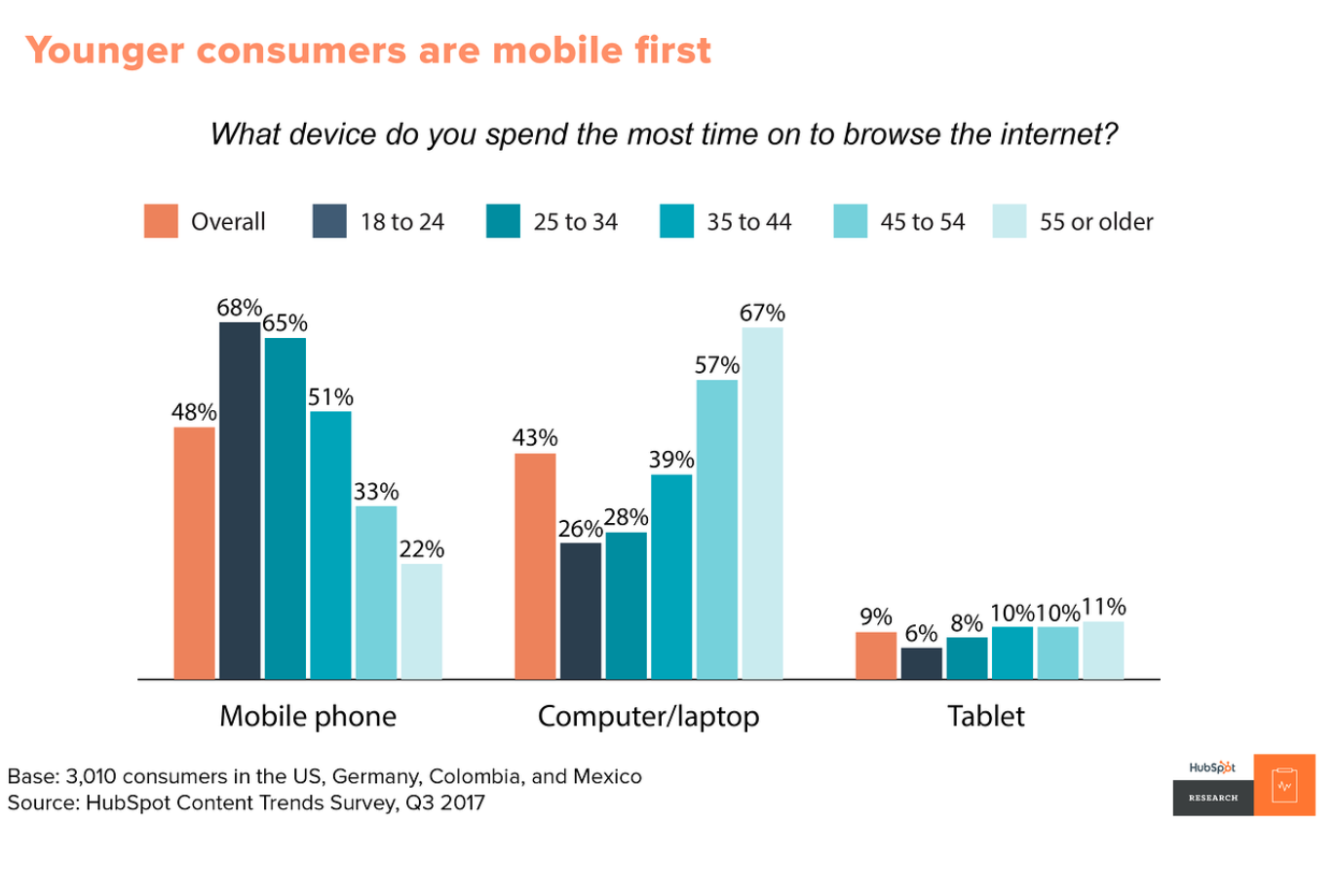
Moreover, people have twice as many interactions with brands on mobile than anywhere else, according to Think With Google. Now more than ever, mobile is where a brand’s target audience is most likely to be, making focused mobile marketing critical.
How to optimize your mobile content marketing strategy
To continuously optimize your mobile marketing strategy, keep these fundamental principles in mind:
1. Focus on readability…
Because mobile audiences have so many options at their literal fingertips, it’s prudent to make your content as direct and readable as possible, by using:
- Short sentences and paragraphs.
- An “above the fold” mentality, putting key content at the top of a page.
- Summary bullets, which help with the above.
- Statistics, which are easy to skim as well as authoritative-sounding.
- Subheads, from H2s on down to H4s.
Bring a similar mobile-first mentality to your emails, which are more likely to be opened on a mobile device than a desktop. Concise headlines, clear CTAs, helpful links and design optimized for phone screens are all important here.
2 …But don’t forget about mobile SEO
SEO and readability aren’t always the best of friends. But it’s still possible to balance the two. Focus in particular on:
- Using keywords as naturally as possible, with no stuffing.
- Tabbed content, which can boost SEO without adding too much text to a tight mobile page view.
- Collapsible accordion menus, which serve a similar purpose in compressing content and saving page space without hurting SEO.
- Responsive web design, so that you can use one URL while accommodating many different mobile device form factors.
- Broader mobile-friendliness, including page load speeds.
3. Break up text with visual content
Many of the examples we looked at earlier used visual content like illustrations right at the top to engage the target audience and dissuade any concerns about having to plow through a bunch of text by itself. Illustrations, screenshots and custom photos are all great ways for varying your mobile content marketing, and preferable to stock photos.
This example from The Omni Group includes an illustrative screenshot, which helpfully supplements an opening paragraph on a well-optimized mobile website:
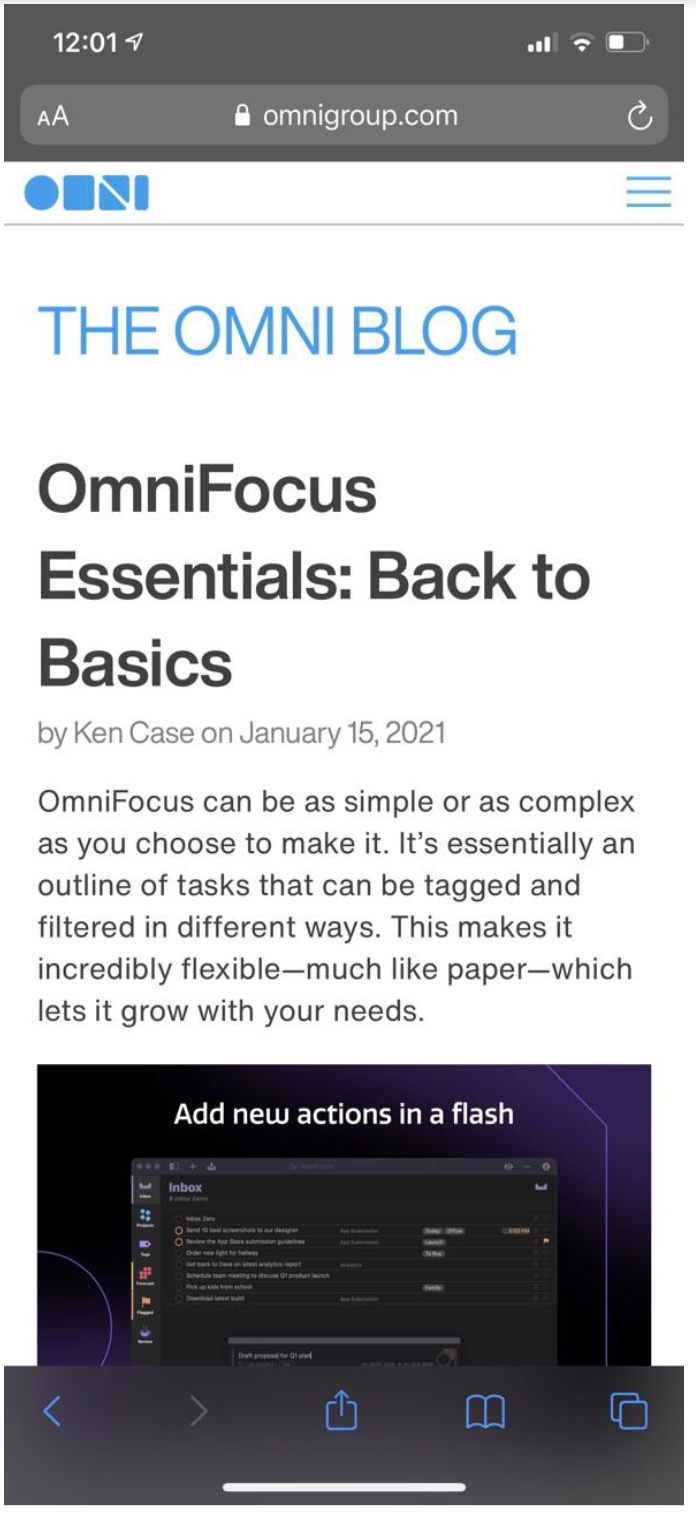
4. Be consistent
There is no recognizable brand voice without consistency. You want to reinforce what you are saying on one mobile marketing channel with your actions on another.
The Google Workspace example from earlier shows how consistency can be enforced across content marketing channels, through consistent colors and imagery, linking and writing style. For marketers, consistency is especially important on social media, due to a large number of platforms and the likelihood of mobile users engaging with content from the same brand across more than one of them.
5. Track your performance
Google Search Console, Google Analytics, Adobe Marketing Cloud, Moz, Constant Contact – are just a few of the numerous mobile content marketing tools you can use to monitor your progress and fine-tune your mobile content marketing strategy accordingly. For a full list covering every stage from content creation to analytics, be sure to check out this comprehensive guide from WordStream.
In a world in which the smartphone is the main device for most people, mobile content marketing is a must, and it pays to do it correctly. We hope this guide has been helpful, and be sure to check out our archive for more guidance and tips!





